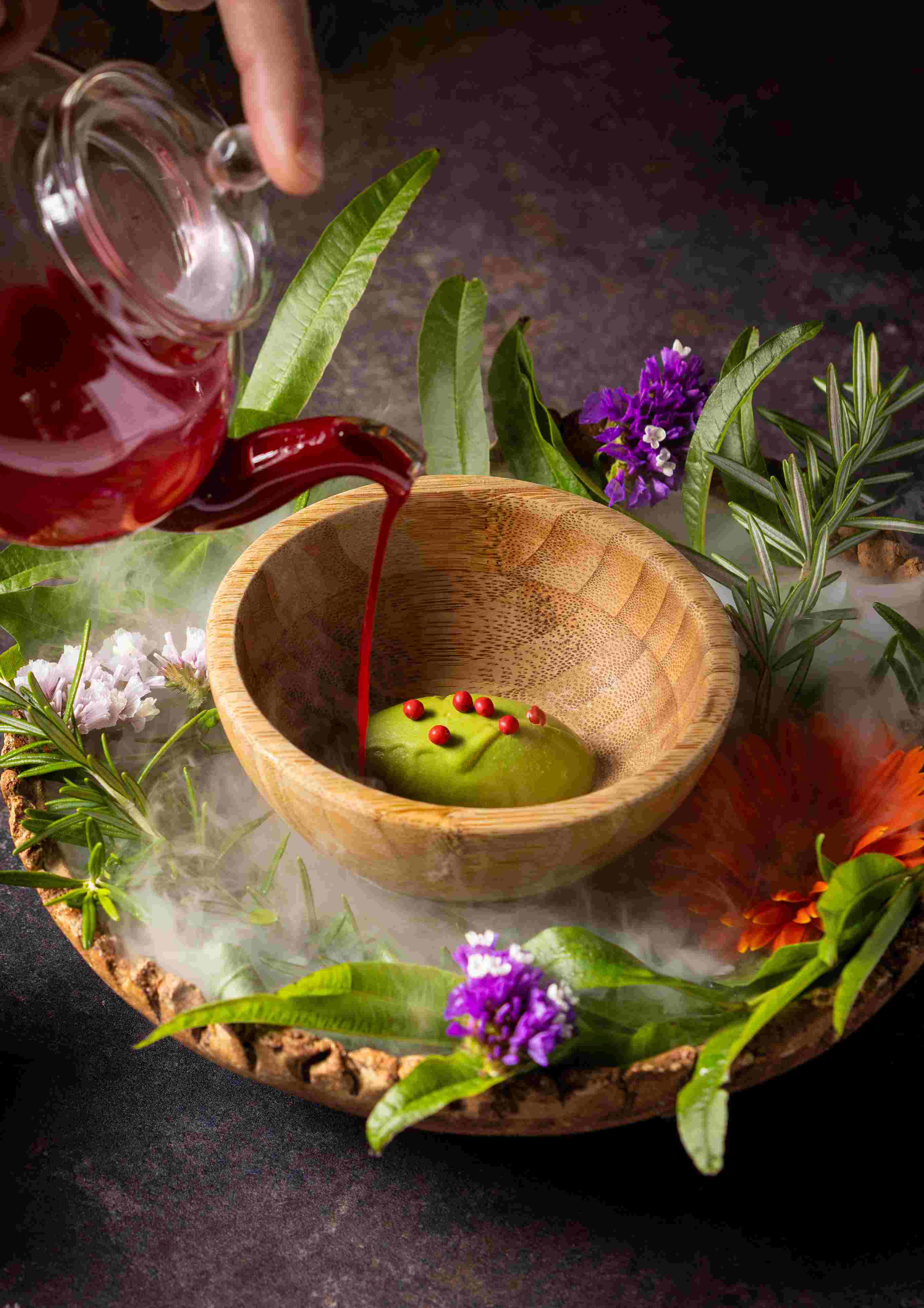Escargot rendang. Avocado gado gado. Pandan custard. And a whole lot of sambal.
Currently one of the only Indonesian restaurants in the MICHELIN Guide in America, Wayan, celebrates Indonesian cuisine with a modern French flair.
Chef and co-owner Cédric Vongerichten has lived across the globe, learning culinary techniques from the best, including his father, acclaimed chef Jean-Georges Vongerichten of Jean-Georges. After many years of refining his craft and forging his own distinct style, Cédric launched Le Burger and Vong Kitchen in Indonesia. Bringing to Jakarta his take on New York-style burgers and other signature dishes, Vongerichten satisfies the cravings of countless locals.
Below, we get the dish on what makes Wayan so tasty, but check out what our Inspectors had to say here.
With Wayan, he does the reverse, bringing a Balinese oasis served family-style to a “fast-paced, high energy downtown” environment in New York. The stone, greenery, and wood teleport guests to island life, giving them a few cozy hours to breathe and step away from the bustling streets of the city.
In Balinese, Wayan means first-born child. Although this is by no means Vongerichten’s first run around the sun, he and wife Ochi (a native Indonesian) proudly created Wayan as their first joint project. The couple met in culinary school, fell in love, and built a family before opening Wayan. Describing how he and Ochi work together, Vongerichten says, “I think we share the same passion. She has a very good palate as we and she really loves food, and I love to create, so we work well together. That’s for sure.”
Being the fourth most populous country in the world and having thousands of islands, Indonesia boasts a rich and diverse culinary heritage. Ranging from barbecue style chicken in Lombok to oxtail soup in Java to babi guling in Bali, the Vongerichtens wanted to “highlight dishes from each region in Indonesia.”

According to Cédric, Indonesian cuisine is, “bold, about strong flavors, [and] fresh flavors.” On the menu, you'll find Indonesian staples including nasi goreng, steamed black sea bass "pepes" enveloped in banana leaves, and various satays. A fan favorite are the Indonesian corn fritters, Wayan's riff off the popular street food. Vongerichten says, “that recipe looks the simplest, but it took a long time to develop the recipe to make sure it was bulletproof and works in this kitchen.”
There’s no soy sauce or olive oil on the dining tables, but guests will find a bright little bottle of red sambal bule (“gringo sambal”), which is Wayan’s take on a condiment that pairs nicely with most dishes. According to Vongerichten, Indonesian cuisine has a lot of chili, and many locals can’t live without it. He notes that there are “hundreds of different types of sambal,” and he appears especially fond of sambal matah from Bali, a refreshing garnish for seafood.
Other menu items feel like a true fusion between Indonesian and French cuisines, such as avocado gado gado, lobster noodles, and chocolate ganache.

In Indonesian, gado gado means “mix mix,” typically with vegetables, eggs, and peanuts. Vongerichten puts his own spin on this classic dish through an emphasis on avocado and quail eggs. For the chocolate ganache, he deconstructs a popular local choco-avocado smoothie into a French ganache with avocado ice cream. "It’s the same elements, and when you eat it together, you can remember the flavors of that smoothie you had in Bali,” says Vongerichten.
Equally delicious are the dishes dusting Indonesian flavors onto classically French fare, such as the pandan custard and escargot rendang.
Fascinated by the classic Indonesian dish rendang, which he describes as “delicious and savory, a mom’s meal at home,” Vongerichten was excited to put his own spin on it. The result? Escargot rendang, which he describes as, “very Indonesian, but not Indonesian at the same time.” He takes the classic French escargot with garlic herb butter and tops it off with Indonesian rendang, bursting with coconut flavor.

And while Cédric might be putting his spin on Indonesian classics, he has picked up a thing or two from his famous and equally talented father. “The first bite of a dish is as important as the last bite,” so it’s important to make his food exciting until the end. This certainly feels true in my dining experience as the final bite of pandan custard magically melts in my mouth.
“Pandan custard is my version of the crème brûlée, but in an Indonesian way. When we set the cream up, we steep it with a lot of pandan leaves. And then on top, we put fresh passion fruit seeds. I don’t like desserts that are too sweet, so if you have a heavy meal, this goes pretty easily. The acidity of the passion fruit, texture of the crunch, creaminess on the bottom, and savory of the pandan works quite well.”

Despite being geographically far from Indonesia and difficult to find the exact ingredients, Wayan puts their local stamp on familiar flavors through sourcing fresh ingredients from nearby farms, including chilis, lemongrass and shallots. Like his father, Cédric frequents the local markets and adapts his menu based on seasonality.
Describing Indonesian dining culture, Vongerichten says, “it’s genuine—the service and the smile. The hospitality is incredible, and this is what we want to recreate and teach our staff—to have Balinese hospitality.”
Seeing New Yorkers routinely visit other cuisines but rarely visit one of the few Indonesian restaurants, Vongerichten wants to “put a spotlight on” Indonesian cuisine in the heart of New York. His eyes sparkle when describing the neighborhood. “This street is so lively. Is it pretty amazing, the energy on this block. So we were blessed for sure.” He and Ochi loved the area so much that next door, they recently opened ma•dé, meaning second-born child. It features fresh seafood and vegetables with inspiration from Bali’s sandy beaches. As to future restaurant “children,” they may not be Indonesian cuisine, but “there will be Indonesian influence.”

For some, Wayan offers a thrilling twist on the familiar flavors of childhood. For others, it “brings back memories of the nasi goreng or satay they had under the sunset when they were vacationing in Bali.” For newcomers, it introduces a first step into a beautiful, foreign cuisine and culture, planting the seed for a dreamy escape to Indonesia.
Vongerichten’s advice for introducing new cuisines to an audience unfamiliar with it? “Go for it.” And no doubt with equal parts Balinese warmth and flavor.

Hero image: Courtesy of Wayan
All photos: Courtesy of Wayan



















